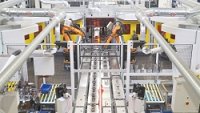Industry 4.0 at CLOOS
07.06.2018
he industrial revolution of Industry 4.0 is advancing with great strides. In the meantime, we take many functionalities and digital supports as granted in our private life. Terms such as "smart car", "smart home", "smart life" etc. are omnipresent.
They also appear more and more in industry. There are "smart products", "smart buildings", "smart logistics" and, of course, also the "smart factory". But how widespread is digitalisation in reality? It is obvious that the demand on and the perception of digitalisation strongly depend on the type of a company. Furthermore, there are very individual ideas within a company and the different departments about the exact meaning of digitalisation and Industry 4.0. Particularly small and medium-sized companies have very different and highly individual conditions and can hardly identify with the big themes of the public discussion. For them, the digital factory and the Internet of Things are often far away and appear to play no role for the own company.
Solutions for future welding technology
But the demands on productivity, repeatability and quality are continuously increasing. At the same time there is often a shortage of skilled employees. In order to successfully meet the growing challenges, the virtual and the physical world will increasingly merge as well. Also in welding technology, digitalisation and networking become more and more important. With the Qirox robots, positioners and special purpose machines Cloos develops and manufactures automated welding systems meeting the specific requirements of the customers. The portfolio comprises simple, compact systems as well as complex systems with automated workpiece identification and loading and unloading processes. But Industry 4.0 is not available off the shelf. Cloos responds to the individual requirements of the customers and they elaborate together the production strategy.
Sensors as basis
Even when the degree of digitalisation strongly differs in the companies, the solutions have many common characteristics. The use of sensors is essential. They supply the data and the signals which are the basis for useful further processing. Monitoring of these sensors - for example those of the welding data - is already a standard function for many companies and thus widely spread. The machine compares the actual values of the component with the specified set values, informs about deviations and can take suitable actions for NOI (not in order) parts.
Furthermore, the information can be used for predictive maintenance. The past experiences form the basis for the future measures.






































